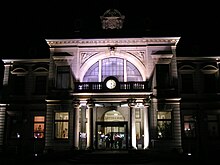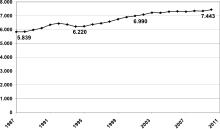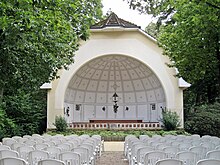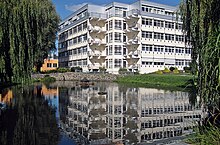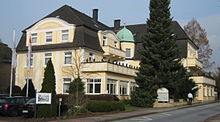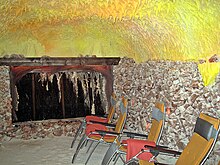Bad Rothenfelde
| coat of arms | Germany map | |
|---|---|---|

|
Coordinates: 52 ° 7 ' N , 8 ° 10' E |
|
| Basic data | ||
| State : | Lower Saxony | |
| County : | Osnabrück | |
| Height : | 96 m above sea level NHN | |
| Area : | 18.21 km 2 | |
| Residents: | 8470 (Dec. 31, 2019) | |
| Population density : | 465 inhabitants per km 2 | |
| Postal code : | 49214 | |
| Area code : | 05424 | |
| License plate : | OS , BSB, MEL, WTL | |
| Community key : | 03 4 59 006 | |
| LOCODE : | DE BG6 | |
| Address of the municipal administration: |
Frankfurter Strasse 3 49214 Bad Rothenfelde |
|
| Website : | ||
| Mayor : | Klaus Rehkämper ( CDU ) | |
| Location of the municipality of Bad Rothenfelde in the district of Osnabrück | ||
Bad Rothenfelde is a municipality in the south of the Osnabrück district in Lower Saxony .
geography
Geographical location
Bad Rothenfelde is located a few kilometers south of the Teutoburg Forest at the transition to East Westphalia and in the city triangle of Bielefeld , Münster and Osnabrück . The highest point is the Kleine Berg ( 208 m ) on the western border of the municipality.
Community structure
The districts of Aschendorf and Strang belong to Bad Rothenfelde.
Neighboring communities
Bad Rothenfelde borders Bad Laer in the west, Hilter am Teutoburger Wald in the north, Dissen am Teutoburg Forest in the east and the North Rhine-Westphalian town of Versmold in the Gütersloh district in the south .
history

The place was mentioned on September 22nd, 1724 on a memorial stone at the old salt spring in the spa garden. This is not a matter of founding a place, but a prerequisite for it. From the discovery of the spring a salt works , a settlement, a peasantry , then a rural community and finally a medicinal bath and a health resort developed. The source was discovered by Johann Christian Märcker on behalf of the Prince-Bishop of Osnabrück, Ernst August II . The first boiling house was built between 1725 and 1726, and salt boiling began. The old graduation tower was built and put into operation from 1773 to 1774 under the direction of the Liège salt inspector.
Rothenfelde was under French rule in 1811, and it was during this time that the first proven healing success through brine baths fell. The new graduation tower was built between 1818 and 1822 under the direction of the Saline Director Schloenbach. The town's citizenship enabled the establishment of a "Badehaus AG" from 1852 and the establishment of a bathhouse with 15 bathtubs. The first spa concert was given by nine Bohemian musicians in 1860. The Rothenfelder Solbad & Salinen AG was founded in 1872 by Heinrich Schüchtermann , Albert Lohmann , Friedrich Vohwinkel and other merchants; she took over the salt works from Prussian ownership and laid out the spa garden. The Rothenfeld family school was founded in 1891 and continued as a private school from 1897. A new salt spring was drilled in 1894. The place was given the name Bad in 1905 , and in 1909 the bath and spa center was opened.
The Knappschafts sanatorium Weidt Mans courtyard was built in 1918; In 1926 the Weidtmanssprudel was drilled . The Wittekindsprudels were drilled from 1930 to 1931. A brine outdoor pool was built in 1933, and the Kurhaus was rebuilt and expanded from 1934 to 1935. The Rothenfeld private school was closed in 1940 by order of the authorities. The place was spared from destruction during the war. At the end of the war there were 10 partial hospitals with around 800 wounded in the village. After the Second World War, the spa business was resumed in 1950 after British occupation.
In the 1950s, the "Helferner Esch" was the first major new building area. The area previously used for agriculture by the General Monastery Fund Hanover was given to those willing to build as a heritable building right . It was decided that the new settlement should have a kind of “garden city character”: The plot areas were cut relatively large and it was important to create spacious front gardens. A “greening” of the settlement should be created with its own planting. The first settlement houses, which were built here with state housing subsidies, thus had a kind of norm character, which changed the appearance of the town, which had hitherto been primarily characterized by resort architecture. In the course of time, the need for more living space in the village grew steadily, so that this typical architectural style disappeared and some construction projects merged into a terraced house character.
In 1965 Bad Rothenfelde was recognized as a state spa. The salt works was closed in 1969 for economic reasons. The bathroom was communalized and the Kurverwaltung GmbH was founded. The municipality and the district were responsible for this; all spa facilities of the former stock corporation were taken over. The Kurhaus, the Kurpark at the new graduation tower and the Brunnenplatz were expanded and renewed from 1971 to 1973. The chimneys in the Salinenhof behind the Kurmittelhaus were demolished in 1972. After a major fire, the Kurhaus was renovated and expanded again. After the road at the bathhouse was closed, the redesigned spa facilities were merged. In 1983 the community became the sole sponsor of the Kurverwaltung GmbH; in the same year, after extensive renovation, the brine outdoor pool was put back into operation. The Dr. Bauer Heimatmuseum was taken over by the community as a foundation in 1986.
The old graduation tower partially collapsed in 1989 and was then completely demolished. The subsequent rebuilding cost 1.73 million euros. The new, much shorter, old graduation tower was inaugurated in 1996. The Kurhaus and the Kursporthalle were privatized in 1997. The rose garden at the new graduation tower was laid out in 1999. A general renovation of the new graduation tower was started in 2002 in three construction phases and completed in 2004. A salt grotto was opened in the Kurmittelhaus in 2005; In the same year the 100th anniversary of the bathroom was celebrated. The indoor brine wave pool was closed at the end of 2010 and demolished in 2011. The new thermal bath was opened in July 2013 and has, in addition to approx. 800 m² of water inside and outside, several sauna areas.
Place name, origin
Old names: 1512 Rodenfelde, 1723 Rahfelde, 1724 Rodenfelde, 1772 Rotenfelde, 1811 Rothenfelde, 1821 Rotenfelde, 1905 Bad Rothenfelde. Rothenfelde - or Low German "on the red field" could indicate the color of the ground.
Incorporations
On April 1, 1974, there was an exchange of territory between the municipality of Bad Rothenfelde and the city of Dissen, in which Bad Rothenfelde gained almost 600 inhabitants and about 100 inhabitants had to cede.
Population development
The following overview shows the population of the municipality of Bad Rothenfelde in each area and on December 31st.
The figures are updates by the State Office for Statistics and Communication Technology Lower Saxony based on the census of May 25, 1987 . The data from 1961 (June 6th) and 1970 (May 27th) are the respective census results within the limits from 1974.
| year | Residents |
|---|---|
| 1961 | 4827 |
| 1970 | 5404 |
| 1987 | 5839 |
| 1990 | 6107 |
| 1995 | 6236 |
| 2000 | 6901 |
| 2005 | 7299 |
| 2010 | 7443 |
| 2011 | 7531 |
| 2013 | 7554 |
| 2017 | 8220 |
| 2018 | 8317 |
politics
Municipal council
The town council of Bad Rothenfelde consists of 20 councilors. This is the specified number for a municipality with a population between 7,001 and 8,000. The 20 council members are elected by local elections for five years each. The previous term began on November 1, 2011 and ended on October 31, 2016.
The full-time mayor Klaus Rehkämper (CDU) is also entitled to vote in the council of the municipality.
The following table shows the local election results since 1996.
| Council of the municipality of Bad Rothenfelde: election results and city councils / councils | |||||||||||||||||||
|---|---|---|---|---|---|---|---|---|---|---|---|---|---|---|---|---|---|---|---|
| CDU | SPD | GREEN | FDP | UB 1 |
Individual applicants |
total | electoral participation |
||||||||||||
| Electoral term | % |
|
% |
|
% |
|
% |
|
% |
|
% |
|
% |
|
% | ||||
| 1996-2001 | 32.3 | 7th | 35.7 | 7th | 6.2 | 1 | 3.9 | 0 | 21.0 | 4th | 1.0 | 0 | 100 | 19th | 66.1 | ||||
| 2001-2006 | 44.2 | 9 | 38.0 | 7th | 4.1 | 0 | 5.7 | 1 | 7.9 | 1 | - | - | 100 | 18th | 54.7 | ||||
| 2006-2011 | 52.7 | 11 | 29.8 | 6th | 5.0 | 1 | 12.4 | 2 | - | - | - | - | 100 | 20th | 52.0 | ||||
| 2011-2016 | 49.3 | 10 | 28.9 | 6th | 16.5 | 3 | 5.4 | 1 | 100 | 20th | 49.7 | ||||||||
| 2016 | 45.4 | 9 | 26.7 | 5 | 18.7 | 4th | 6.7 | 1 | 2.6 | 1 | 100 | 20th | 52.5 | ||||||
|
Percentages rounded. Sources: State Office for Statistics and Communication Technology Lower Saxony, District Osnabrück. In the case of different information in the sources mentioned, the data from the State Office for Statistics and Communication Technology were used, as they are generally more plausible. 1 independent Bad Rothenfeld citizens |
|||||||||||||||||||
mayor
The full-time mayor of Bad Rothenfelde is Klaus Rehkämper (CDU). In the last mayoral election on May 25, 2014, he was re-elected as incumbent with 64.1% of the vote. His opponent Marco Neisen (independent) received 35.9%. The turnout was 56.2%. Rehkämper began his further term on November 1, 2014.
coat of arms
The coat of arms of the municipality of Bad Rothenfelde shows the front wall of the graduation tower and above it the standing Osnabrück wheel.
flag
The flag of the municipality shows the front wall of the graduation tower and above it the standing Osnabrück wheel on a white and red background.
Town twinning
Bad Rothenfelde's partner municipality is Avereest, Hardenberg (Overijssel) , in the Netherlands .
religion
Since the Reformation , the population of Bad Rothenfelde has mostly belonged to the Protestant denomination.
Evangelical Church: 46.0%, Catholic Church: 26.8%, other (including non-denominational): 27.2%
Culture and sights
Museums
Local museum
music
Concert garden, Dissen-Bad Rothenfelde Jazz Club, Haus des Gastes
Parks
The place has an approximately 18-hectare spa park with two graduation towers and three ponds. The first graduation tower was built in 1777. The second followed in 1824, with a length of 412 meters. This graduation tower has no lateral struts and is therefore the largest column-free in Western Europe. In 2008, the reconstruction of a wind art was built on the "New Graduation Tower", a coker windmill that used to be used to pump the brine onto the Graduation Tower.
Since 1999 there has also been a rose garden with around 3000 roses.
Sports
- TuS Bad Rothenfelde offers aerobics , badminton , gymnastics , jazz dance , psychomotor skills, sports badges , Nordic walking , swimming , table tennis , gymnastics and volleyball .
- SV Bad Rothenfelde : Soccer, Landesliga Weser-Ems
- Tennis Club Bad Rothenfelde e. V. with basketball department
- SSG Bad Rothenfelde: shooting sports
- Sole outdoor pool with sports pool 50.0 × 18.0 m, non-swimmer pool 17.5 × 12.5 m, water slide with its own pool 37.0 m long
- Indoor swimming pool (thermal bath)
movie theater
Kurlichtspiele with 228 seats
Regular events
Festivals
Salt market (from Corpus Christi), Nicholas and Christmas market (2nd Advent), Quellenfest (penultimate weekend in September), Heimatfest (third weekend in August), phylloxera (wine festival) (July), rose season (July), Bad Rothenfeld literature days (September ), Mini-Olympics in the Teutoburg Forest (May).
Light sight
Since 2007, the " Lichtsicht " biennale has been held in Bad Rothenfelde every two years . In the dark , light artists use the long sides of the new and old graduation towers, but also fountains as surfaces for various light installations.
Views
Economy and Infrastructure
According to the GfK Germany purchasing power index, Bad Rothenfeld's population has above-average purchasing power. The reason for this is, among other things, that Bad Rothenfelde is a preferred and expensive residential area for commuters from the surrounding area and senior citizens. Bad Rothenfelde includes residential areas with villas and some senior citizen facilities.
Clinics
Bad Rothenfelde has several clinics of national importance. In 2002 the community had around 1080 clinical employees and around 125 doctors and 20 psychologists.
Teutoburg Forest Clinic
The clinic is part of the German Pension Insurance Braunschweig-Hannover . It was opened in 1955 as one of the first German sanatoriums for rehabilitation after heart attacks. In addition to cardiovascular diseases, metabolic diseases, respiratory diseases and concomitant diseases are treated.
Münsterland Clinic
The clinic is run by the German Pension Insurance Westphalia . It is an orthopedic-rheumatological rehabilitation clinic, also for follow -up rehabilitation after stays in an acute hospital. The house has 195 single rooms, 20 of which are handicapped accessible. Together with the Teutoburg Forest Clinic, it forms the Bad Rothenfelde Rehabilitation Clinic.
Schüchtermann Clinic
The Schüchtermann Clinic was opened in 1973. The cardiological clinic bears the name of the Dortmund entrepreneur Heinrich Schüchtermann , who was one of the founders of Rothenfelder Solbad und Salinen AG in 1872 . The clinic, which belongs to the Schüchtermann-Schiller'schen Family Foundation, is one of the most efficient heart centers in Germany. More than 92,500 cardiac catheter examinations were performed at the clinic between 1977 and 2009 and more than 39,000 cardiac operations with heart-lung machines between 1993 and 2009. Bad Rothenfelde erected a monument to the namesake in the spa gardens. In October 1998, cardiac surgeon and heart transplant pioneer Christiaan Barnard (1922–2001) paid a visit to the clinic.
Park clinics
The Parkklinik Bad Rothenfelde is a specialist clinic for orthopedics and trauma surgery, rheumatology, follow-up treatment (AHB), interdisciplinary pain therapy, psychosomatic medicine and psychotherapy as well as internal comorbidities. The Parkklinik I with the orthopedic department was opened in 1986. The psychosomatic department was opened in 1996 in the new buildings of Parkklinik II. The Parkklinik Bad Rothenfelde had a total of 295 beds in 2012.
Clinic in the Kurpark
In the clinic in the Kurpark , which opened in 1996, diseases of the musculoskeletal system, psycho-vegetative exhaustion, and respiratory and cardiovascular diseases are treated.
Johann Wilhelm Ritter Clinic
The clinic bears the name of the physicist and philosopher Johann Wilhelm Ritter (1776–1810). It is an acute, follow-up treatment and rehabilitation clinic for skin and allergy diseases. The clinic, which was founded in 1986, is located in the building of the former Oldenburg children's spa, which has been in existence since 1917 .
Eye Clinic Dr. George
The private eye clinic Dr. Georg was founded in Bad Rothenfelde in 1960 by the doctor Fritz Georg. It is based in the Ewers House , built in 1905 , which has served as a reserve hospital and hotel guesthouse throughout its history. In the clinic, eye operations are carried out on an inpatient and outpatient basis, as well as pre- and follow-up examinations.
tourism
In Bad Rothenfelde there has been a five-star campsite since April 2000 with fitness, sauna and physiotherapy options under the name Campotel. The place also has numerous hotels and pensions.
Established businesses
- Heristo AG (food industry)
- Apotal.de mail order pharmacy (operated by the Bad Apotheke, Bad Rothenfelde). Takeover by the Zur Rose Group in June 2020.
traffic
Bad Rothenfelde is connected to the trunk road network via the Niedersachsenring at the Dissen / Bad Rothenfelde junction of the A 33 federal motorway.
The station Dissen-Bad Rothenfelde is located on the railway line Osnabrück-Bielefeld ( KBS 402 ) on the hourly, the regional train "Haller Willem" RB 75 runs. Local rail passenger transport is carried out by NordWestBahn , which uses Talent diesel multiple units. The station is part of the Westfalentarif tariff association ; the VOSplus tariff applies to Osnabrück .
In road passenger transport associate regional buses to Osnabrück, Münster , Bad Iburg and since 21 August 2008, after Versmold . There are regular bus routes from Bad Rothenfelde to Osnabrück on two routes: one via Bad Laer, Bad Iburg and another via Dissen, Hilter. There is also a bus connection from Bad Rothenfelde, ZOB (in the center) to and from the trains at Dissen-Bad Rothenfelde station.
Educational institutions
- primary school
- Community library
- Branch of the Volkshochschule Osnabrück
- Regional office of the Osnabrück district music school
Personalities
Sons and daughters of the church
The following personalities were born in Bad Rothenfelde:
- Franz Bitter (1865–1924), member of the Reichstag (center), born in Aschendorf
- Christian Oertel (1884–1945), general manager of insurance companies
- Hans-Jürgen Fip (* 1940), politician (SPD)
- Hans Meiser (* 1946), television presenter
- Christa Röber (* 1946), educator
- Claus Sprick (* 1946), judge at the Federal Court of Justice and the European Court of Human Rights
- Burkhard Pauge (* 1949), lawyer, judge at the Federal Court of Justice, born in the Strang district of Bad Rothenfeld
- Cora Stephan (* 1951), journalist and author
- Christine van den Heuvel (* 1952), historian and archivist
- Eduard Mühle (* 1957), historian
- Gabriele Seifert (* 1959), artist
- Enak Ferlemann (* 1963), politician (CDU)
- Heiner Kamp (* 1964), politician (FDP), born in the Bad Rothenfeld district of Strang
People related to the place
- Hermann Heinrich Grafe (1818–1869), founder of the Free Evangelical Congregation and hymn poet
- Heinrich Schüchtermann (1830–1895), entrepreneur in Dortmund, co-founder of Rothenfelder Saline AG
- Alfred Bauer (1878–1955), spa doctor, local researcher, collector and founder of the Dr. Bauer local history museum
- Theodor Krieghoff (1879–1946), composer, military musician, musician with the local spa orchestra
- Albrecht Stalmann (1880–1967), President of the monastery chamber in Hanover, did a great job developing the “Helferner Esch” residential area
- Walther Wenck (1900–1982), officer, general of the armored forces , lived in Bad Rothenfelde
literature
- Bad Rothenfelde spa administration (ed.), Georg Münzberg (editor): 200 years of the Rothenfelde spa. EBB Verlag, Glandorf 2011, ISBN 978-3-00-036025-1 .
- Rolf Westheider, Richard Sautmann: Bad Rothenfelde. Pictures from days gone by. Sutton Verlag, Erfurt 2004, ISBN 3-89702-661-9 .
- Gerhard Ohlhoff (Ed.): Bad Rothenfelde. From salt works to medicinal baths. Bad Rothenfelde 1986, ISBN 3-7729-3105-7 .
- Alfred Bauer: Bad Rothenfelde and its surroundings. 2nd Edition. H. Beucke & Sons Verlag, Dissen 1952.
Web links
Individual evidence
- ↑ State Office for Statistics Lower Saxony, LSN-Online regional database, Table 12411: Update of the population, as of December 31, 2019 ( help ).
- ^ Jürgen Udolph (research): The "place name researcher". In: website NDR 1 Lower Saxony . Archived from the original on September 22, 2014 ; accessed on October 6, 2018 .
- ↑ a b Federal Statistical Office (ed.): Historical municipality register for the Federal Republic of Germany. Name, border and key number changes in municipalities, counties and administrative districts from May 27, 1970 to December 31, 1982 . W. Kohlhammer, Stuttgart / Mainz 1983, ISBN 3-17-003263-1 , p. 259 .
- ↑ State Office for Statistics and Communication Technology Lower Saxony, population update ( page no longer available , search in web archives ) Info: The link was automatically marked as defective. Please check the link according to the instructions and then remove this notice.
- ^ Lower Saxony Municipal Constitutional Law (NKomVG) in the version of December 17, 2010; Section 46 - Number of MPs , accessed on December 6, 2014
- ↑ State Office for Statistics and Communication Technology Lower Saxony, Table 5000311
- ↑ Landkreis Osnabrück, official final results of the district election on September 9, 2001 ( Memento from May 25, 2005 in the Internet Archive ) (PDF; 528 kB)
- ^ The local elections for the district of Osnabrück on September 11, 2011 (also includes 2006 results). (PDF; 8 MB; p. 67, column “Municipal elections ”) In: www.landkreis-osnabrueck.de. District of Osnabrück, accessed on March 6, 2016 .
- ↑ Individual results of the direct elections on May 25, 2014 in Lower Saxony ( Memento of the original from March 3, 2016 in the Internet Archive ) Info: The archive link was inserted automatically and has not yet been checked. Please check the original and archive link according to the instructions and then remove this notice. , accessed November 9, 2014.
- ↑ a b Main statutes of the Bad Rothenfelde community. (PDF; 2.4 MB) (No longer available online.) In: Website of the Bad Rothenfelde community. November 15, 2011, p. 1 , archived from the original on March 4, 2016 ; accessed on October 6, 2018 .
- ↑ Partnerships are like friendships NOZ, August 3, 2004
- ↑ 2011 census
- ↑ Light art at the graduation tower . Homepage of the 2nd Bad Rothenfelde Projection Biennale
- ^ Lichtsicht 2011, 3rd Projection Biennale. October 1, 2011 to January 8, 2012
- ↑ GfK in your country. In: www.gfk.com. June 3, 2016, accessed June 7, 2016 .
- ↑ Information from the Schüchtermann Clinic 2009 ( Memento from April 10, 2009 in the Internet Archive )
- ^ Herbert Mensen: Bad Rothenfelde. From salt works to medicinal baths. In: Heimatbund Osnabrücker Land, Kreisheimatbund Bersenbrück (Ed.) Heimat-Jahrbuch 2003 Osnabrücker Land. Georgsmarienhütte 2002, p. 43.
- ^ Johann Wilhelm Ritter Clinic
- ^ Herbert Mensen: Bad Rothenfelde. From salt works to medicinal baths. P. 44.
- ↑ Query of course book route 402 at Deutsche Bahn.




